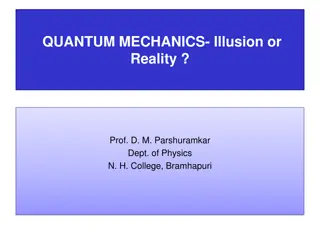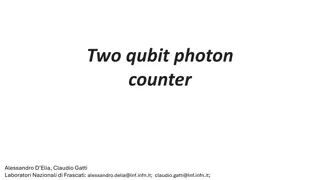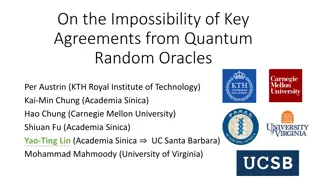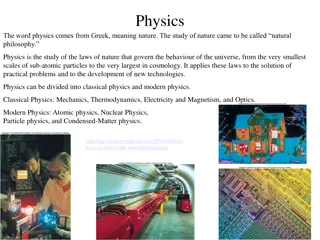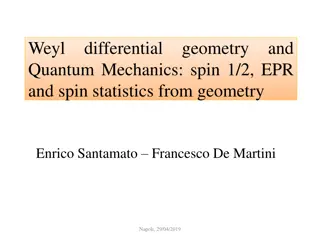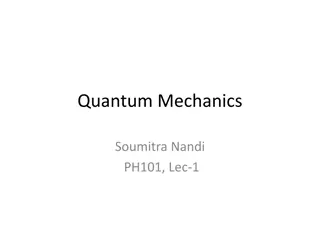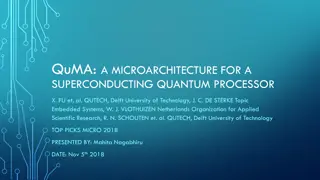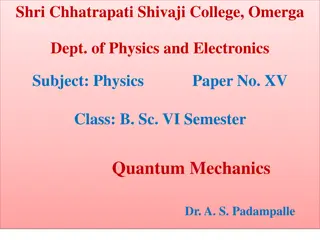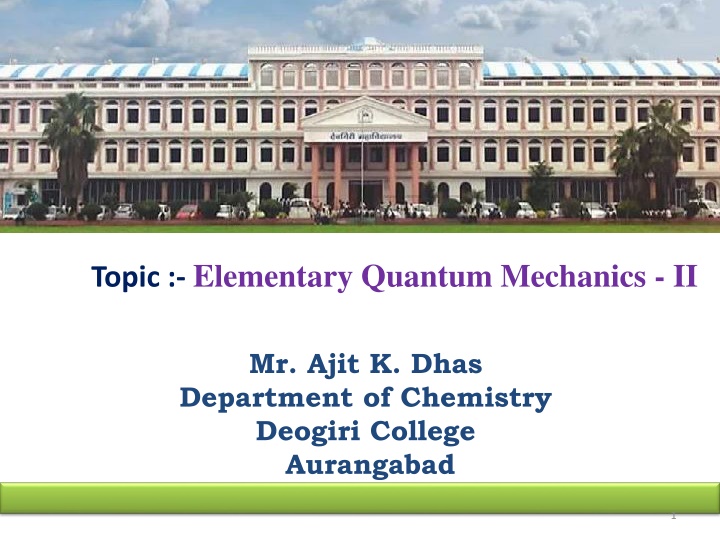
Elementary Quantum Mechanics - II and Its Key Concepts
Explore the concepts of Elementary Quantum Mechanics - II as taught by Mr. Ajit K. Dhas at Deogiri College, focusing on topics like Bohr's model of the hydrogen atom, the Compton effect, De Broglie Hypothesis, and the Heisenberg uncertainty principle.
Download Presentation

Please find below an Image/Link to download the presentation.
The content on the website is provided AS IS for your information and personal use only. It may not be sold, licensed, or shared on other websites without obtaining consent from the author. If you encounter any issues during the download, it is possible that the publisher has removed the file from their server.
You are allowed to download the files provided on this website for personal or commercial use, subject to the condition that they are used lawfully. All files are the property of their respective owners.
The content on the website is provided AS IS for your information and personal use only. It may not be sold, licensed, or shared on other websites without obtaining consent from the author.
E N D
Presentation Transcript
Topic :- Elementary Quantum Mechanics - II Mr. Ajit K. Dhas Department of Chemistry Deogiri College Aurangabad 1
Elementary Quantum Mechanics Content: Bohr's model of hydrogen atom (no derivation) and its defects, Compton effect, De Broglie Hypothesis, The Heisenberg s uncertainty principles.
Introduction In the late 17th century, Isaac Newton discovered Classical Mechanics, the science of motion of macroscopic (large) objects. This Newtonian science successfully explained the motion of particle from everyday objects to planets. However, towards the end of 19th century, classical mechanics was unable to correctly describe the behavior of microscopic particles such as electrons and nuclei of atoms and molecules (subatomic particles). This quest to understand the microscopic behavior gave birth to a new theory called Quantum Mechanics. Undoubtedly, quantum mechanics came as the greatest intellectual developments of the 20th century.
What is Quantum Mechanics? The term Quantum Mechanics is made up of two words QUANTUM + MECHANICS. The term Mechanics refers to the science of motion of the body. The other word is Quantum which is Latin word for amount and in modern conventions is used to represent smallest possible discrete unit of any physical property. Quantum Mechanics replaces Classical Mechanics at the atomic or subatomic levels (electrons and nuclei in atoms and molecules). It gives the laws of motion of microscopic objects (the way classical mechanics gives for macroscopic objects). So, Quantum Mechanics is the theoretical science of microscopic matter.
Compton effect 1. In 1923 Compton investigated the scattering of X-rays by crystals and found that the wavelength of the scattered radiation is greater than the wavelength of the incident radiation. 2. The observe change in wavelength of the scattered radiation is found to be independent of the wavelength of the incident radiation. 3. This change in wavelength or frequency of the scattered radiation is known as Compton Effect. 4. When an incident photon strikes an electron at rest, there will be an inelastic collision between the photo and electron of the scatter. 5. The photon will transfer kinetic energy and momentum to the electron and therefore the scattered photon will have lower energy than the incident photon.
Compton effect 1. Let a photon of energy hv collide with electron of rest mass m. Then, after collision, the scattered photon will have energy hv. 2. Let and be the angles of the scattered photon and the scattered electron (recoil electron) respectively with the direction of the incident photon. 3. The change in wavelength due to scattering can be determined by,
Bohr atomic model The electrons in an atom revolve round the nucleus in definite circular orbits. Each orbit is associated with a definite amount of energy and the energy of an electron remains constant so long as it stays in that orbit. Such a state is known as a stationary state and each state corresponds to a certain energy level or energy shell. Electrons in these states do not radiate energy. The emission or absorption of energy in the form of radiation can only occur when an electron moves from one stationary state to another. Energy is not emitted or absorbed gradually but in units of hv (known as Quantum) where, h is Planck's constant and v is the frequency of the radiant energy.
Bohr atomic model The farther the energy level from the nucleus, the greater is the energy associated with it Energy is absorbed when the electron jumps from an inner to an outer orbit and is emitted when it moves from an outer to an inner energy level. The size of the quantum emitted or absorbed is determined by the energies of the electron in the initial and final stationary states. If E, and E, are the energies of the initial and final states respectively and v is the frequency of the energy emitted, E = E2 E1= hv. When an electronic transition from one stationary state to another takes place so as to release energy, an emission spectrum is produced; when energy is absorbed an absorption spectrum is formed. The energy associated with each orbit is governed by the condition that the angular momentum (mvr) of the electrons revolving in the orbits can have only some discrete value. Which is a simple whole number multiple of a definite quantity, h/2 . mvr = n h/2 Where, n=1, 2, 3, 4 .
Limitations of Bohr Atomic Model Theory 1. It violates the Heisenberg Uncertainty Principle. The Bohr atomic model theory considers electrons to have both a known radius and orbit i.e. known position and momentum at the same time, which is impossible according to Heisenberg. 2. The Bohr atomic model theory made correct predictions for smaller sized atoms like hydrogen, but poor spectral predictions are obtained when larger atoms are considered. 3. It failed to explain the Zeeman effect when the spectral line is split into several components in the presence of a magnetic field. 4. It failed to explain the Stark effect when the spectral line gets split up into fine lines in the presence of an electric field.
Heisenbergs Uncertainty Principle In 1927, Heisenberg proposed uncertainty principle. A direct consequence of wave-particle duality of matter as well as radiation led to Heisenberg Uncertainty Principle. This principle states that It is not possible to determine accurately both the position and momentum of a small moving particle simultaneously. ? ?. ? ? /4? ? or ? ?. m v /4? ? Where, ?= Uncertainty in position ?= Uncertainty in momentum = Planck s constant
Physical Significance of Heisenbergs Uncertainty Principle 1. This principle explains why it is possible for radiation and matter to have dual nature. 2. It helps in understanding many phenomenon like absence of electrons within nucleus, existence of protons & neutrons in nucleus, binding energy of an electron in atom etc. 3. It also states that we can only predict the probable behavior of quantum mechanical systems & not the exact behavior.
De Broglie Hypothesis In 1923, Louis de Broglie extended the concept of wave-particle duality to electrons and hypothesized that electrons can also behave as waves. This hypothesis was tested and confirmed experimentally in what became known as the Davisson-Germer experiment. In this experiment, electrons were accelerated at a metal surface, scattered onto a viewing screen and produced a diffraction pattern, which can only be explained using wave properties. In later experiments, it was shown that other subatomic entities, such as neutrons and protons can behave as waves. In fact, all ordinary macroscopic objects can behave as waves or as particles and this became known as the wave-particle nature of matter.
De Broglie Hypothesis E= mc2 ----------------------------------------------1 And E=hv ------------------------------2 Therefore, mc2 = hv ------------------------------3 Since, v = c/ By putting above value of in equation 3, we get, mc2 = hc/ mc= h/ But mc= momentum Therefore, h/p = ---------------- De Broglie equation
Problem: 1 What is the de-Broglie wavelength of a baseball with mass 120 gm and a speed of 44.7 m/s? Solution- M= 120 gm = 0.120 kg C=44.7 m/s h = 6.626 x 10-34 JS According to de-Broglie equation, But p = mv = 1.23 x 10-34 m = h/ p = h/ mv = 6.626 x 10-34 / 0.120 x 44.7
Problem: 2 A moving electron has 4.55 x 10-25 J of kinetic energy. Calculate the wavelength. (mass of electron= 9.1 x 10-31 kg, h= 6.626 x 10-34 JS) Solution- M= 9.1 x 10-31 kg h = 6.626 x 10-34 JS K. E. = mv2 4.55 x 10-25= x 9.1 x 10-31 kg x v2 Therefore, v2 = 2 x 4.55 x 10-25 / 9.1 x 10-31 = 106 v = 103 m/s Now, According to de-Broglie equation, But p = mv = 7.25 x 10-7 m = h/ p = h/ mv = 6.626 x 10-34 / 9.1 x 10-31 x 103


